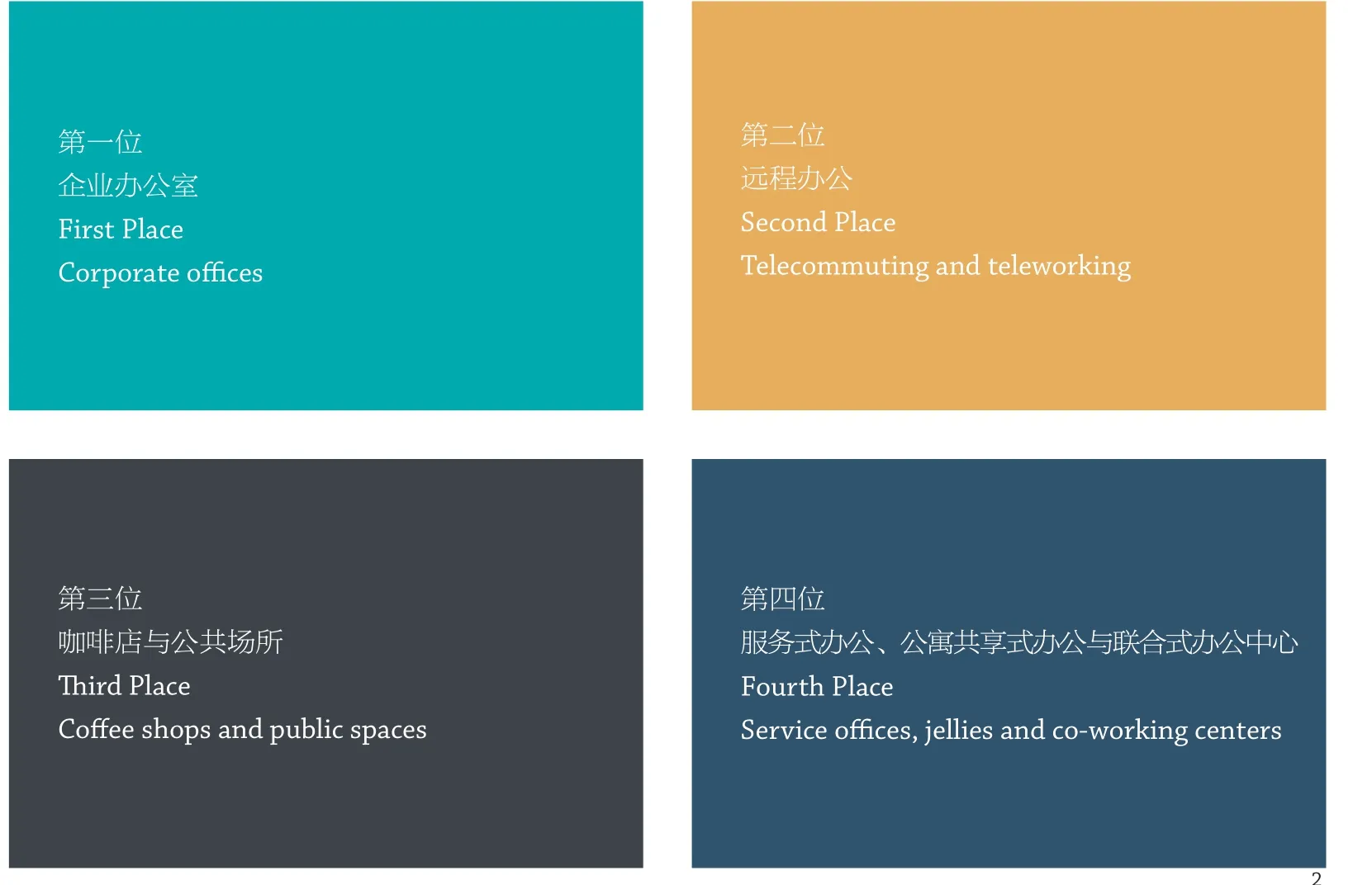联合办公解析
2018-03-20萨金特KaySargent
凯·萨金特/Kay Sargent
王欣欣 译/Translated by WANG Xinxin
刘晓音 校/Proofread by LIU Xiaoyin

1 HOK2016年发布的白皮书《联合办公:来自企业地产的观点》/2016 HOK Co-working: A Corporate Real Estate Perspective
你是否被现代办公场所——联合办公的出现所吸引?这里有一些数据:在10年之间,世界范围内致力于联合办公的场所数量就从0增长到了11,000个。到2020年,又将有15,000个工作空间诞生,而这些机构可以容纳3,800,000个会员。
还有一些引人注目的数据:尽管增长迅速,联合办公空间的占比仍然小于全球办公空间的5%。如今,全球的联合办公空间分布为:
·亚洲1000万平方英尺(约93 万m2)
·欧洲2000万平方英尺(约186万m2)
·美洲4000万平方英尺(约372万m2)
但是联合办公的占比有望持续增长,有可能在可见的将来超过企业办公市场的10%~20%,有些大胆的预测则更高。根据仲量联行(JLL)近期的调查显示,到2030年30%的商业办公空间将作为“灵活空间”使用。此外,大约1/5的公司正将联合办公作为房地产资产组合策略的一部分,大于2/3的公司明确表示计划以某种形式推行联合办公空间。
然而在展望之前,让我们先回顾一下联合办公空间的发展。2016年初,CoreNet的英国分会向HOK提出了一个简单的问题:“联合办公会影响企业地产吗?如果会,如何影响?”这个问题引发了2016年10月颁布的名为《联合办公:来自企业地产的观点》的白皮书。报告指出,联合办公对房地产社群具有颠覆性的影响,但也讨论了产业未来的走向。2016年的报告总结道:
工作不再是于单一地点发生的事。由于科技和其他资源的支持,工作可以在很多地方发生。联合办公在某个组织的空间样式中的角色必须基于自身的特点——而非依照别人的做法或者媒体所预言的未来的工作方式。尽管联合办公空间所占当今企业房地产市场的份额很小,它的比例无疑将在未来的3~5年内持续增长。新生代的企业家、非固定劳动力的增长以及对企业市场的适度渗透将成为未来需求的驱动力。但是,随着租约到期续签、现有商家期望扩张、新商家加入市场,供给成本将升高,营业毛利会受到影响。
联合办公的早期成功某种程度上受到了希望获得新选择的工作者的支持,受益于在经济大衰退之后不顾一切想要把空房填满的房主们。由于用户义务是灵活的而租期却不是,比起传统的工作场所,更高的租金或者下一个经济大萧条可能会更快地影响联合办公。对于企业占用人和其他地产专业人士来说,联合办公的趋势绝对是值得关注、探索和试验的。
联合办公演变
The evolution of co-working

2 联合办公演变/The evolution of co-working
Intrigued by the emergence of the modern workplace – co-working? Consider the following data: In just over a decade, the number of dedicated co-working spaces worldwide has grown from zero to 11,000. By 2020, another 15,000 of these shared workspaces will come online and membership to these facilities could eclipse 3.8 million users.
Here is another stat worth knowing: Despite its meteoric growth, co-working still accounts for less than 5% of global office space. Today co-working space around the world equates to:
· 10 million square feet (MSF) in Asia
· 20 MSF in Europe
· 40 MSF in the Americas
But co-working's overall slice of the pie is expected to continue to grow and could reach more than 10-20% of the corporate office market in the foreseeable future, with some more aggressive predictions estimate it would be even greater.According to recent research from JLL, 30 percent of all commercial office space is projected to be consumed as "flexible space" by 2030. In addition,while approximately just 1 in 5 companies currently incorporate co-working as part of their real estate portfolio strategy, more than 2 out of 3 have noted that they plan to leverage co-working space going forward in some form or another.
But before we look forward, let's look at the evolution of co-working spaces, in early 2016 HOK was asked a simple question by the UK Chapter of CoreNet: "Will co-working impact corporate real estate, and if so how?" That question lead to the October 2016 release of the white paper "Coworking: A Corporate Real Estate Perspective." The paper addressed the impact co-working is having as a disruptor in the real estate community but also looked at what lies ahead for the industry. The 2016 report concluded…
Work no longer happens in a single place.Thanks to technology and other resources, it happens in many places. The role that co-working plays in an organisation's palette of spaces must be based on its own DNA – not what others are doing or what the media portends to be the future of work.Although co-working space accounts for a small percentage of today's corporate real estate market,its share will undoubtedly continue to grow over the next three to five years. Demand will be driven by new generations of entrepreneurs, growth of the contingent workforce and modest penetration of the corporate market. But supply will come at a higher cost and challenge operator margins as leases come up for renewal, existing players look to expand, and new entrants join the market.
Co-working's early success has been fuelled in part by workers who wanted new options,benefitting from desperate landlords seeking to fill empty space during and after the Great Recession.Because user commitment is flexible but leasing terms are not, higher lease rates or the next big economic downturn may impact co-working more quickly than traditional workplaces. For corporate occupiers and other real estate professionals, the coworking trend is certainly worth watching, exploring and testing.
But within less than two years of the release of HOK's co-working report, the co-working industry has continued to rapidly advance and morph in new directions. And the trend is only picking up speed, what's also clear is that the concept of coworking (which arguably began just over a decade ago with the 2006 openings of the Hat Factory and Citizen Space in San Francisco) is now one of the biggest disruptors within the commercial real estate industry.
Given the impact that co-working is having,how should workplace designers and end users approach the opportunity at hand? At HOK, we've developed nine key insights we often share with clients who are considering co-working.
1 Co-working reflects changing work attitudes
Fewer and fewer employees think of work as something that has to be done within the traditional office. As many as 80 percent of knowledge workers report spending at least one day a week working remotely. These professionals tend to view the office as just the first of their workplace options. Home is often a second workplace and a coffee shop or public space, such as a library, is a third alternative.

3 WeWork中国上海云南南路共享空间/WeWork Yunnan Rd Commons Shanghai, China(图片来源/Courtesy of WeWork)
但是在HOK的联合办公报告颁布的两年时间内,联合办公产业持续快速地向新的方向发展和变化。而且这种趋势正在加速。还有一点也很明确,联合办公(其充满争议地诞生于10多年以前,也就是2006年Hat Factory和Citizen Space在旧金山开业之后)现在已经极大程度地影响了商业地产。
鉴于联合办公的影响,工作场所的设计者和终端用户应该如何接近唾手可得的机会?HOK总结了9个关键点并且时常与关心联合办公的客户分享。
1 联合办公反应变化的工作态度
越来越少的雇员认为工作需要在传统办公室中完成。80%之多的知识工作者自称每周至少有一天时间花在远程工作上。这些专业人士倾向仅仅将办公室作为他们工作场所的首选。自己的家通常是第二个被选择的工作场所,而咖啡馆或者公共空间,比如图书馆,则是第三个选项。
致力于联合办公的空间——有着共享办公桌、高速Wi-Fi以及社交休息室——已经成为形象专业、灵活、便于交流的第四种可供选择的工作场所。最初,联合办公起源于大量的自由职业者和独立合约工作者的需求。然而近期联合办公队伍的组成发生了转变。越来越多的雇主(包括HSBC、Verizon、 IBM、 GE、Delta Airlines、KPMG 及其他公司)将联合办公作为解决工作空间短缺和安置远程或临时员工的办法,现在联合办公的人群中雇员的比例已经过半。
2 雇员更倾向于联合办公
调查显示相比传统办公室,雇员和自由职业者都更喜欢联合办公空间。根据行业贸易出版物Deskmag的数据,79%的联合办公成员声称在工作中觉得开心,而非联合办公者的这个比例只有59%;68%的人说他们可以更好地集中精力;而62%的人认为自己工作的质量更好。很多这些联合办公者说他们喜欢开放共享办公空间的社交属性,以及和自己志同道合的专业人士分享想法的可能性。
促成这些空间成功的关键是它们创造了社群氛围,提供了灵活性和适用空间的选择。社区经理和共享空间的管理员在创建一个引人注目和诱人的用户体验以及确保社群联系方面扮演着关键的角色。及时提供用户所需的场所与服务是让他们日常工作体验发生转变并使共享空间运营成功的基础。
联合办公者希望从社区中得到什么7项会员希望从其他会员身上获得的
What co-workers want from the community Top seven items members expect from other members

4 联合办公者联合办公者希望从社区中得到什么/What coworkers want from the community
3 雇主从联合办公中受益
联合办公为雇主提供了诸多好处,尤其体现在房地产存量和人力资本方面。如前面提到的,雇员通常表示更希望选择联合办公。相比每天去办公室上班的人,那些每周有一至两天可以远程工作的人认为自己对工作的投入程度更高。
几个大型公司已经开始实验将联合办公作为一种联结创新者和挖掘人才的途径。比如,Verizon公司去年将曼哈顿办公室的一部分改造成了联合办公空间,据公司的全球地产总监称,这将会帮助电信公司保持“在(技术)社群中的参与度”。
4 联合办公的挑战
尽管联合办公具有优势,但风险仍然存在。在这个行业里,几乎没有门槛,竞争日益激烈,租户基础易变,租约逐渐增多,联合办公很容易受到市场条件的影响。未来的雇员是否还会像今天的一样欣赏联合办公也是不得而知的。此外,市场和竞争也可能给联合办公带来直接的挑战。
联合办公模式需要大量会员来支付运营费用。联合办公者平均会员时长在14个月以下,所以这些机构的会员情况是在持续变化中的。租赁价格也是其中一个因素。在美国以及欧洲、中东和非洲的大多数联合办公空间是在经济大萧条过后房地产价格相对较低的情况下涌现而出的。2018年,预计有将近一半的联合办公空间需要续租。
有些运营机构,比如WeWork,已经在欧美许多大城市开设了许多共享办公空间,致使那里的联合办公市场达到了饱和。相反,在亚洲和拉丁美洲,竞争还不是那么激烈,主要是过去5年内,联合办公模式刚刚进入市场,强烈的需求才刚刚开始。
5 考虑商业和个体的需求
最终,不管商业还是组织,在考虑联合办公前都必须具体问题具体分析。对于很多雇主来说,尤其是那些需要很多人际合作的,联合办公可能不是个好选择。对于其他人,也还有很多需要考虑的问题。
以下是我们给客户提出的问题:
·这个空间是如何反应企业品牌或身份的?
·联合办公空间的目标是什么?是让闲置的房地产产生利润吗?是增加雇员的产能吗?是为了联结社群吗?
Dedicated co-working spaces – with their shared desks, fast Wi-fiand social lounges – have emerged as a fourth place for professionals looking for greater choice, flexibility and community.Initially, co-working drew from the large numbers of workers who identify as freelancers and independent contractors. Recently, however, the composition of co-working has shifted. Salaried workers now represent slightly more than half of all co-workers as more and more employers (including HSBC, Verizon, IBM, GE, Delta Airlines, KPMG and others) have seized upon co-working as a solution to workspace shortages and housing for remote or temporary staff.
2 Employees tend to enjoy co-working
Surveys shows that both employees and freelancers prefer co-working spaces over traditional office environments. According to the industry trade publication Deskmag, 79% of co-working members report being happy at work compared to just 59% of non-co-workers. Additionally, 71% of co-workers say they're more productive in a co-working space; 68%say they're better able to focus; and 62% believe the quality of their work is better. Many of these same co-workers say they enjoy the social aspects of the open and shared workspace and the ability to share ideas with like-minded professionals.
The key elements that feed the success of these spaces are their ability to create curated community and providing flexibility and choice. Community managers, the concierges of these spaces, play a pivotal role in creating a compelling and enticing user experience and enabling community connections. Giving users what they need, when and where they need it while connecting them to a network of on-demand space and services transform the workday experience and is fundamental to the success of these spaces.

5 光华路SOHO 3Q联合办公空间,北京,中国/Guanghua Road SOHO 3Q, Beijing, China(摄影/Photo: Dirk Weiblen)
·空间应如何结合所有工作者的需求和喜好?这些需求会随时间发生什么变化?
·附近有其他的联合办公空间吗?使用的情况如何?
6 从小社群到大商业的持续演化
在过去的几个月里,随着联合办公模型在新的商业模式和环境中得到应用,我们看到了它持续进化的新阶段。开发商开始把他们的建筑内部空间分配给社群式联合办公空间。这些空间被视作吸引和联结租户的共享设施,就像健身中心曾经的作用一样。
我们还看到许多城市中的联合办公空间从小型社区聚点变成了“大盒子”式的空间。对于一些人来说,这种大空间失去了精品的感觉和社群的意义,而正是这些特点从一开始吸引了人们。鉴于超过50%的联合办公空间使用者现在是某个公司的雇员,一些公司正在重新考虑他们的策略。对于另一些人来说,联合办公让他们可以少负担永久空间的费用或者将这些空间用作富余空间以满足人员变化的需求。
举个恰当的例子,为了扩大他们的数字容量,HSBC在WeWork共享空间租用了超过300个公用办公桌。尽管包括HSBC在内的公司均坚持表示他们进入联合办公产业的主要原因并非为了节省开支,但和传统方式相比,这种经过计算的方式的确会节省这些公司的总房地产花销。推行的原因也是因为如此门槛低,退租容易的联合办公空间给他们的团队提供了所需的快速便利的使用空间。
7 空间即服务,SaaS
联合办公供应商刚推出的“管理式办公室”的服务同样对企业具有吸引力。这些空间起到了服务办公室的作用,但遵循着更加传统的商业房地产(CRE)租赁模型。当我们从简单地提供空间演变为创造现在被称为“空间即服务”(SaaS)的时候,场所的重要性具有了新的意义。管理式工作空间推出个性化的办公室和服务,与此同时仍然提供简单快捷地进驻一级市场空间的方式,省去长期租赁的需要、家具和设备的采购,以及所有权所带来的责任和要求。这种情况对于需要迅速扩张、增长模式不固定和/或缺乏开发新工作空间资源的公司是很理想的选择。多数情况下,传统的联合办公公司会采用这种模型,将大型空间甚至整栋楼出租,以便为有大型空间需求的公司提供支持。这些管理式办公室通常提供某种程度的个性化及安保服务,同时还配有社区经理。如需增加便利设施的确需要增加费用;提供全套服务的管理式办公室需要15%~20%的额外费用,租用义务也有所延长(通常3~5年)。

6 Sinèrgics联合办公空间,巴塞罗那,西班牙/Sinèrgics,Barcelona, Spain(摄影/Photo: Roberto Ruiz)
8 按需分布的空间
我们也注意到了一种更加注重规避风险的模式的出现。业主免费向进驻并运营联合办公中心的个体提供空间,共同承担收益和风险。这种模式减轻了长期租约带来的风险,使各方没有束缚可以更快地顺应市场和供需的变化。
各个公司不仅欣然接受联合办公的应用,还开始创造属于自己的版本。越来越多的公司打算在自己的空间内复制联合办公的体验。创意办公室和创客空间的崛起,加之社区经理根据企业空间需求提供服务,都给联合办公环境带来了新的竞争浪潮。从健身房、图书馆到企业,更大范围和更多样性的组织与公司加入了联合办公的队伍。这引发了一个新问题——“联合办公空间是否正成为许多建筑的新设施,或者甚至成为企业空间配置的新标准?”比如Verizon公司,就计划在更多的公司地产里开设新增的联合办公空间。
9 在中国的发展
中国本土最大的共享办公创业公司优客工场在20个城市设有分支,是目前市场的主导者。但是源于美国的联合办公巨头WeWork在全球范围内扩张迅速,并且已经瞄准了中国市场。WeWork于2016年在中国开设了第一个共享办公空间,并且在上海已经很有影响力。目前WeWork在中国运营了12个中心,除了上海外,主要位于北京和香港。然而明年WeWork准备在中国大陆的其他城市开设更多的中心,包括武汉、西安、深圳、苏州、杭州、厦门、成都和南京。据悉,现有空间的90%已被使用,需求是显著的。WeWork也在寻求亚洲其他国家的机会,计划在韩国、日本和东南亚实施扩张策略。
要点导读
基于过去10年的惊人增长,事实表明联合办公并非一时热潮。联合办公的供应商将继续延展和演变传统的房地产模型,并且会对传统房地产交付模型产生重大干扰。干扰的强烈程度仍待观察,但是重整状态已经明确形成。
·联合办公是商业地产市场增长速度最快的行业之一。
· 联合办公快速增长的原因是社会学、经济学、人口学和技术因素的汇总,包括不固定劳动力的上升、雇员-雇主合约存在的断层、共享经济的发展以及科技的进步。
3 Employers benefit from co-working
Co-working offers employers several advantages,particularly when it comes to real estate inventory and human capital. Employees, as we just mentioned,usually express favourable opinions of co-working.Those who have the flexibility to work remotely a day or two each week actually report feeling more engaged in their jobs than those who work in the office every day.
Several large companies have begun experimenting with co-working as a way to connect with innovators and tap into talent. Verizon, for example, last year converted part of its Manhattan office into coworking space that, according to the company's global head of real estate, will help the telecom stay"engaged in the [tech] community."
4 Challenges of co-working
Although there are advantages to co-working,there are also risks. In an industry with few barriers to entry, mounting competition, a volatile tenant base, and looming lease increases co-working is heavily susceptible to market conditions. It's also impossible to know if tomorrow's employees will appreciate co-working quite as much as today's workers. In addition, market forces and competition may present immediate challenges to co-working.
The co-working model requires large membership to cover operating costs. Yet with the average co-worker keeping a membership for just under 14 months, membership to these facilities is in constant flux. Lease rates could also prove to be a factor. Most co-working spaces in the US and in EMEA sprouted up in the wake of the Great Recession, when real estate was relatively inexpensive. In 2018, the leases for nearly half of all co-working spaces are expected to be up for renewal.
It could be, too, that co-working has already reached market saturation in many large U.S.and European cities, where operators such as WeWork have opened multiple shared workspaces.Competition doesn't pose quite such a risk in Asia and Latin America, though there the coworking model has only recently been introduced,primarily within the past five years, and is just now experiencing strong demand.
5 Consider the needs of the business and the individual
Ultimately, whether or not a business or organisation should pursue co-working can only be made on a case-by-case basis. For many employers,particularly those that require lots of in-person collaboration, co-working may not be an option. For others, there are many questions to address.
Here are some that we ask our clients:
· How will the space reflect your corporate brand or identity?
· What is the goal of the co-working space? Is it to monetise unused real estate? Increase employee productivity? Connect with the community?
· How will the space incorporate the needs and preferences of all workers? And how might those needs change over time?
· What other co-working spaces can be found nearby and how are they being used?
6 Continued evolution from small communities to big business
In the past several months we seen co-working continues to evolve into new phases as the model get adopted into new business models and settings.Developers are starting to allocate space within their buildings to serve as a community/co-working space. These spaces are seen as a shared amenity that attract and connect tenants, just as fitness centres once did.
We're also seeing co-working goes from being a small community hotspot to becoming"big box" environments in many cities. For some,these large environments lose the boutique feel and sense of community that was so appealing in the first place. Considering that more than 50% of co-working occupants are now employees of a company, corporations are rethinking their strategy. For some, co-working affords them to commit to less permanent space while other use it as overflow space to meet changing staffing needs.
Case in point, in an effort to build up its digital capabilities, HSBC has booked more than 300 hot desks at WeWork. The calculated difference between the two options could reduce their overall real estate spend though HSBC and others insisted that the move to co-working isn't primarily about saving costs. The press is attributed to a need and a desire for quick and easy access to space with low barriers to entry and an easy exit strategy while giving their teams the options and choices they are looking for.
7 Space as a service, SaaS
Co-working providers are also appealing to corporations with the emergence of the "managed office." These spaces act like a serviced office but in a more traditional CRE leasing model.The importance of place takes on new meaning as we evolve beyond simply providing space to creating what's now referred to as "Space as a Service", SaaS. The managed workspace allows for customisation of the office and services, while still offering easy and quick access to space in prime markets and reduces the need for long-term leases,furniture and equipment procurement, and the liability and demands of ownership. This scenario can be ideal for companies that need to expand rapidly, unpredictable growth patterns, and/or a lack of resources to develop a new workplace.In many cases traditional co-working companies are engaging this model and leasing large blocks of space, and in some cases entire buildings, so they can offer larger blocks of space to companies in need of such support. These managed offices typically offer some degree of customisation and security while also providing the service of community managers. Added amenities do come with a premium, however, with fully serviced managed offices demanding an upcharge of between 15 to 20 percent and an extended period of obligation to the space (typically 3-5-year commitments).
8 Space where you need it
We are also seeing the emergence of a more risk-averse co-working model. In such a building owner offers available blocks of space free of charge to an entity that comes in to operate the co-working centre thus sharing the reward and risk. This model alleviates the risk associated with longer term leases and frees up all parties to react more quickly to changing market conditions,supply and demand.
·变化的商业优先级和吸引人才的需要、房地产开支的减少、创新效率和产能的增加都促使企业开始考虑不同的工作场所模型,包括现场和离场的联合办公。
·联合办公的概念正演变成包涵了加速器、孵化器和创客空间的集合。联合办公超越了办公室的设定,还将大学校园、零售中心、酒店和图书馆包括在内。
·联合办公在欧洲、中东、非洲和北美洲已趋完善,部分市场临近饱和。不过联合办公在亚太地区正迅速增长,在拉丁美洲尚处初期。
·联合办公空间对于商业房地产(CRE)的影响包括在现存设施中为老旧产业和未充分使用的空间开发新用途。
·大多数在联合办公中心工作的人士是某个组织的雇员,其余则是自由工作者或个体经营的企业家。
·参与水平最低的是从未远程工作过的雇员,远程工作时间占总工作时间少于20%的人士表现出最高的参与水平。
·许多联合办公中心出现在高失业率和低房租的时期。但是54%的联合工作者会在一年内离开某个特定的地方。高流动率和租户不稳定性会影响联合办公中心的收益。市场环境和新的竞争对手使联合办公中心处于弱势。
·各个公司将开始创立他们自己的联合办公品牌。
·“大盒子”联合办公将进入更多的市场,具有规模的公司会租用管理式办公空间的多个整层空间。
·开发商会将建筑中的更多空间用于创建联合办公设施。

7 utopic_US联合办公Conde de Casal,马德里,西班牙/Co-working utopic_US Conde de Casal, Madrid, Spain(摄影/Photo: Miguel de Guzman. Imagensubliminal.)
·尽管联合办公空间在全球办公空间占有的比例很小,但这代表了一种重要的劳动力趋势,凸显了如今雇员对于工作场所选择、社群和灵活度的强烈需求。□
Companies are starting to not only embrace the use of co-working, they are creating their own version of them. More and more companies are looking to replicate the co-working experience within their own space. The rise of the creative offices and maker spaces, coupled with the introduction of community managers to service the corporate space needs, is bringing a new wave of competition to co-working environments as well. As a broader and more diverse number of organisations and companies – from gyms, libraries and corporations enter the co-working game, it begs the question – "Are co-working spaces becoming the new amenity in many buildings, or even the new norm for corporate space?" Verizon, for one, plans to open up additional co-working spaces elsewhere in their properties.
9 Expansion in China
UrWork (changed the name as UCOMMUNE from December 2017), the largest China based office-sharing start-up has locations in 20 Chinese cities and is the dominate player in the market.But WeWork, a co-working giant founded in the US has been rapidly expanding globally, and has their sights set on China. WeWork opened their first space in China in 2016 and already has a strong presence in Shanghai. They currently operate 12 centres in China, primarily in Beijing and Hong Kong, in addition to their spaces in Shanghai. But WeWork is looking to open even more centres in the coming year in other mainland Chinese cities, including Wuhan, Xi'an, Shenzhen, Suzhou,Hangzhou, Xiamen, Chengdu and Nanjing. With a reported 90% occupancy of their existing spaces,the demand is apparent. WeWork is also looking to other countries in Asia and looking to develop strategies for expansion for Korea, Japan and Southeast Asia.
Key takeaways
Based on its tremendous growth in this past decade, it's clear that co-working is much more than a fad. Co-working providers will continue to stretch and evolve the traditional real estate model and be a major disruptor to the traditional real estate delivery model. How disruptive that force will be remains to be seen, but a rebalancing is definitely in the making.
· Co-working is one of the fastest-growing sectors of the commercial real estate market.
· The rapid growth of co-working stems from a confluence of societal, economic, demographic and technological factors including the rise of the contingent workforce, a rift in the employeeemployer contract, development of the sharing economy and advances in technology.
· Changing business priorities and the need to attract talented people, reduce real estate costs, improve speed to innovation and increase productivity are driving corporations to consider different workplace models, including co-working,both on- and off-site.
· The co-working concept is evolving to comprise accelerators, incubators and maker spaces.It reaches beyond office settings to include college campuses, retail locations, hotels and libraries.
· Co-working is well-established in EMEA and North America, where it is approaching saturation points in some markets. But it is still emerging,although rapidly, in Asia Pacific and in its infancy in Latin America.
· The impact of co-working spaces on CRE includes providing new uses for older properties and for underutilised spaces in existing facilities.
· The majority of people working in co-working centres are employees of an organisation, versus freelance workers or self-employed entrepreneurs.
· The lowest engagement levels are found in employees who never work remotely. The highest employee engagement levels occur among those who work remotely less than 20% of the time.
· Many co-working centres emerged in a time of high unemployment and low rents. But 54%of the co-workers will leave a specific location in less than a year. The high turnover and tenant instability challenge co-working centres to maintain profitability. They are vulnerable to market conditions and new competitors.
· Companies will begin to create their own coworking brands.
· "Big box" co-working will enter more markets and established companies will take multiple floors in managed office spaces.
· Developers will set aside more space in buildings to create co-working as an amenity.
· Although co-working space makes up a small percentage of the world's office space, it represents an important workforce trend and highlights the strong desire of today's employees to have workplace choices, community and flexibility.□

8 WeWork中国上海云南南路共享空间/WeWork Yunnan Rd Commons Shanghai, China(图片来源/Courtesy of WeWork)
